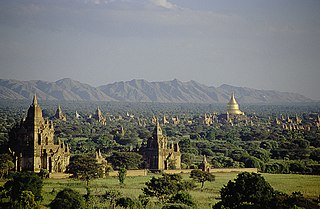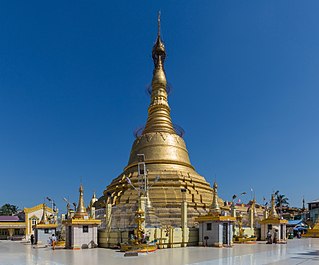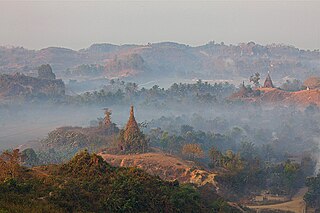 W
WThe Alo-daw Pyi Pagoda, also known as the Alodawpyi Pagoda or Alodawpyay Pagoda, is a Buddhist temple in Bagan, Bago Region, Myanmar. Built in the early 12th century, the temple is notable for its old structure and a number of fresco paintings. The temple has been the subject of restorative efforts—funded by donations given by General Khin Nyunt—since 1994, and is a popular pilgrimage site. The temple's name translates to "Wish-fulfilling".
 W
WBagan is an ancient city and a UNESCO World Heritage Site in the Mandalay Region of Myanmar. From the 9th to 13th centuries, the city was the capital of the Pagan Kingdom, the first kingdom that unified the regions that would later constitute Myanmar. During the kingdom's height between the 11th and 13th centuries, more than 10,000 Buddhist temples, pagodas and monasteries were constructed in the Bagan plains alone, of which the remains of over 2200 temples and pagodas survive.
 W
WThe Botataung Kyaik De Att Pagoda is a famous pagoda located in downtown Yangon, Myanmar, near the Yangon river. The pagoda was first built by the Mon around the same time as was Shwedagon Pagoda—according to local belief, over 2500 years ago, and was known as Kyaik-de-att in Mon language. The pagoda is hollowed within, and houses what is believed to be a sacred hair of Gautama Buddha.
 W
WChaungtha is a town and beach resort located in Ayeyarwady Region, Myanmar. Chaungtha Beach, as it is more commonly known, is about 5 hours' drive away from Yangon, and is a popular resort with Yangonites from October to April. As it is relatively more affordable than the nearby Ngwesaung and Ngapali beaches, Chaungtha is also more crowded and less cleanly than the two more expensive and better maintained beaches.
 W
WThe Goteik viaduct also known as Gohteik viaduct) is a railway trestle in Nawnghkio, western Shan State, Myanmar. The bridge is between the two towns of Pyin Oo Lwin, the summer capital of the former British colonial administrators of Burma, and Lashio, the principal town of northern Shan State. It is the highest bridge in Myanmar and when it was completed, the largest railway trestle in the world. It is located approximately 100 km northeast of Mandalay.
 W
WHanlin is a village near Shwebo in the Sagaing Division of Myanmar. In the era of the Pyu city-states it was a city of considerable significance, possibly a local capital replacing Sri Ksetra. Today the modest village is noted for its hot springs and archaeological sites. Hanlin, Beikthano, and Sri Ksetra, the ancient cities of the Pyu Kingdom were built on the irrigated fields of the dry zone of the Ayeyawady River basin. They were inscribed by UNESCO on its List of World Heritage Sites in Southeast Asia in May 2014 for their archaeological heritage traced back more than 1,000 years to between 200 BC and 900 AD.
 W
WHpaung Daw U Pagoda, also spelt Hpaung Daw Oo or Phaung Daw Oo) is a notable Buddhist site in Myanmar, located on the Inle Lake in Shan State.
 W
WHtukkanthein is one of the most famous temples in the ancient Arakanese city of Mrauk U, in Rakhine State, Western Myanmar. The name means "Cross-Beam Ordination Hall".
 W
WInle Lake, a freshwater lake located in the Nyaungshwe Township of Shan State, part of Shan Hills in Myanmar (Burma). It is the second largest lake in Myanmar with an estimated surface area of 44.9 square miles (116 km2), and one of the highest at an elevation of 2,900 feet (880 m). During the dry season, the average water depth is 7 feet (2.1 m), with the deepest point being 12 feet (3.7 m). During the rainy season, this can increase by 5 feet (1.5 m).
 W
WThe Kaunghmudaw Pagoda is a large pagoda on the northwestern outskirts of Sagaing in central Myanmar (Burma). Modeled after the Ruwanwelisaya pagoda of Sri Lanka, the Kaunghmudaw is known for its egg-shaped design, which stands out among more traditional-style, pyramid-shaped Burmese pagodas. The stupa's formal name Yaza Mani Sula signifies the enshrinement of Buddhist relics inside its relic chamber. But it is commonly known by its popular name, Kaunghmudaw. It is an important pilgrimage and tourist destination in the Sagaing area.
 W
WKyaukkhauk Pagoda is a Buddhist stupa located in Thanlyin Township, in southern Yangon Region, Myanmar. It is a popular tourist destination and also pilgrimage site for Buddhists. It is believed that the pagoda was built on Hlaingpotkon Hill about 2000 years ago by King Sulathrima of Thaton. There are four stairways and the pagoda resembles a Mon-style stupa. A pagoda festival is held annually in February of each year. During Cyclone Nargis, the pagoda, which was located on higher elevation, served as a storm shelter for local villagers.
 W
WKyaiktiyo Pagoda is a well-known Buddhist pilgrimage site in Mon State, Burma. It is a small pagoda built on the top of a granite boulder covered with gold leaves pasted on by its male devotees.
 W
WMaungmagan is a village and beach located approximately 12 kilometres (7.5 mi) north-west of Dawei, the capital of Taninthayi Division. It is the second oldest beach locale established in Myanmar after Ngapali.
 W
WThe Memorial to the Fallen Heroes is a memorial in Nay Pyi Taw, Myanmar (Burma) to honour and enshrine the inscriptions of the name of Myanmar’s soldiers and civilians who heroically died in their fight for independence and counter-insurgency operations as well as those who died in doing notable and courageous actions for the country. It was opened in March 2017.
 W
WThe Mingun Pahtodawgyi is an incomplete monument stupa in Mingun, approximately 10 kilometres (6.2 mi) northwest of Mandalay in Sagaing Region in central Myanmar. The ruins are the remains of a massive construction project begun by King Bodawpaya in 1790 which was intentionally left unfinished. The pahtodawgyi is seen as the physical manifestations of the well known eccentricities of Bodawpaya. He set up an observation post on an island off Mingun to personally supervise the construction of the temple.
 W
WMrauk U is an archaeologically important town in northern Rakhine State, Myanmar. It is also the capital of Mrauk-U Township, a sub region of the Mrauk-U District. From 1430 until 1785, it was the capital of the Mrauk U Kingdom, the most important and powerful Rakhine (Arakanese) kingdom.
 W
WNgwesaung is a beach resort located 48 km west of Pathein, Ayeyarwady Region, Myanmar. The beach is 5 hours drive, with no traffic, away from the principal city of Yangon, and an airport is in the works. Buses leave at 6am & 9:30pm from in front of the Yangon Central Railway Station. Opened in March 2000, Ngwe Saung is newer than nearby and more popular Chaungtha Beach, and is designed to attract people with larger holiday budgets.
 W
WPhaung Taw Oo Pagoda is a historical Buddhist stupa located in Lewe Township, Naypyidaw Union Territory, Myanmar.
 W
WPhowintaung is a Buddhist cave complex located approximately 25 kilometres (16 mi) west of Monywa and 10 kilometres (6.2 mi) southeast of Yinmabin, in Yinmabin Township, Monywa District, Sagaing Region, Northern Burma (Myanmar). It is located on the western bank of the Chindwin River. The name of the complex means Mountain of Isolated Solitary Meditation.
 W
WThe Pon Daw Pagoda is a small pagoda in Mingun, Myanmar. Built in 1799, the temple is a miniature version of the larger, incomplete Mingun Pahtodawgyi, which was abandoned due to cost overruns. The Paw Daw Pagoda resembles what the Pahtodawgyi was intended to look like when it was complete.
 W
WMount Popa is an extinct volcano 1518 metres (4981 feet) above sea level, and located in central Myanmar in the region of Mandalay about 50 km (31 mi) southeast of Bagan (Pagan) in the Pegu Range. It can be seen from the Ayeyarwady (Irrawaddy) River as far away as 60 km (37 mi) in clear weather. Mount Popa is a pilgrimage site, with numerous Nat temples and relic sites atop the mountain.
 W
WThe Shaitthaung Temple, also spelled Shitthaung according to Standard Burmese pronunciation, is a famous temple in Mrauk U. The name means 'Temple of 80,000 Buddha Images', and is also known as the 'Temple of Victory'.
 W
WThe Shwedagon Pagoda, officially named Shwedagon Zedi Daw and also known as the Great Dagon Pagoda and the Golden Pagoda, is a gilded stupa located in Yangon, Myanmar.
 W
WSunye Lake, also known as Sunye In, is a freshwater natural lake located near Kyaukse and Sintgaing, the large inland body of standing water is known as "little Inle". The Shan Yoma Mountain Ranges sited at the east of the Lake. Sunye Lake is a tourist destination and famous for its blossoming lotus flowers in the rainy season and migratory birds in the cool season. The Lake designated as protected wetlands to conserve and regulate development. Sunye Lake has existed for generations and has a great history of repairing and maintaining it by ancient kings.
 W
WThe Thanbyuzayat War Cemetery is a prisoner of war cemetery for victims of Japanese imprisonment Who died building the Death Railway in Burma. It is at the Burmese end of the Second World War railway construction, in Thanbyuzayat, 65 kilometres south of Mawlamyine (Moulmein). Thanbyuzayat is considered the terminus of the Death Railway, and is where it connected with the Burmese main line.
 W
WThandwe is a town and major seaport in Rakhine State, the westernmost part of Myanmar. Thandwe is very ancient, and is said to have been at one time the capital of Rakhine State, then called Arakan. The district has an area of 3,784 square miles (9,800 km2). The area is mountainous, and spurs of the Arakan Mountains reach the coast. Some of the peaks in the north are over 4,000 feet (1,200 m) high. The streams are only mountain torrents to within a few miles of the coast; the mouth of the Khwa forms a good anchorage for small boats. The rocks in the Arakan Range and its spurs are metamorphic, and include clay, slates, ironstone and indurated sandstone; towards the south, ironstone, trap and rocks of basaltic character are common; veins of steatite and white fibrous quartz are also found. Between 1961 and 1990, the mean annual rainfall was 5,323 millimetres (209.6 in). Nearby Ngapali Beach is popular among tourists.